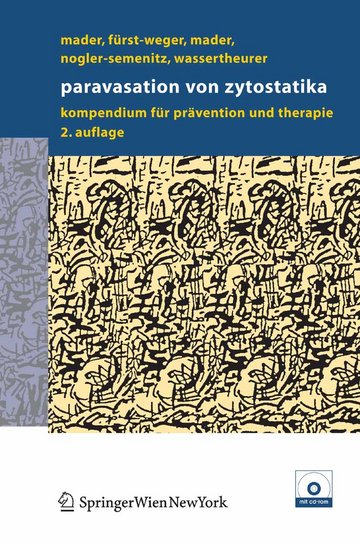| Vorwort zur 2. Auflage | 5 |
| Vorwort von 1. Auflage | 7 |
| Inhaltsverzeichnis | 9 |
| Einleitung | 13 |
| Allgemeiner Teil | 16 |
| Einführung und Definitionen | 17 |
| Prädisposition und Prävention | 24 |
| Klinik | 34 |
| Maßnahmen | 50 |
| Nachsorge | 82 |
| Dokumentation | 83 |
| Die Gründung klinischer Arbeitsgruppen | 88 |
| Qualitätskontrolle und Qualitätssicherung | 90 |
| Offene Fragen und Ausblick | 92 |
| Literatur | 98 |
| Substanzspezifischer Teil | 110 |
| Erläuterungen zum substanzspezifischen Teil | 111 |
| Amsacrin (z.B. Amsidyl®) | 114 |
| L-Asparaginase (z.B. Asparaginase medac) | 119 |
| Bendamustin (z.B. Ribomustin®) | 123 |
| Bleomycin (z.B. Bleomycin „Baxter“, | 127 |
| Bleomedac®) | 127 |
| Bortezomib (z.B. Velcade®) | 131 |
| Busulfan (z.B. Busilvex®) | 134 |
| Carboplatin (z.B. Carboplatin „Ebewe“, | 137 |
| Paraplatin®) | 137 |
| Carmustin (z.B. Carmubris®) | 141 |
| Cisplatin (z.B. Cisplatin „Ebewe“, Platinol®) | 146 |
| Cladribine (z.B. Leustatin®) | 153 |
| Cyclophosphamid (z.B. Endoxan®, Endoxan | 157 |
| „Baxter“) | 157 |
| Cytarabin (z.B. Alexan®, Udicil®) | 162 |
| Dacarbazin (z.B. Dacarbazine medac, | 166 |
| DTIC-Dome) | 166 |
| Dactinomycin (z.B. Cosmegen®) | 172 |
| Daunorubicin (z.B. Daunoblastin®) | 177 |
| D Schädigungstyp: | 177 |
| D und Therapie. Dtsch Med Wochenschr 130: 33–37, 2005. | 183 |
| Daunorubicin liposomal (z.B. Daunoxome®) | 184 |
| D potentiell nekrotisierend [6,10] | 185 |
| D daunorubicin (Daunoxome) in advanced malignancies. Proc ASCO 11: | 187 |
| Docetaxel (z.B. Taxotere®) | 188 |
| D [3] Panday VR, Huizing MT, Huinink WW, et al: Hypersensitivity reactions to | 193 |
| Doxorubicin (z.B. Doxorubicin „Ebewe“, | 195 |
| Adriblastin®) | 195 |
| D surgical treatment and possible prevention of skin and soft-tissue injuries. | 207 |
| D and daunorubicin hydrochloride. Am J Hosp Pharm 41: 2410–2414, 1984. | 209 |
| D ports. Oncol Nurs Forum 27: 531–538, 2000. | 211 |
| Doxorubicin liposomal (z.B. Caelyx®) | 212 |
| Doxorubicin pegyliert liposomal | 212 |
| (z.B. Myocet®) | 212 |
| Epirubicin (z.B. Epirubicin „Ebewe“, | 217 |
| Farmorubicin®) | 217 |
| Estramustin (z.B. Estracyt®) | 224 |
| E In der Literatur keine Angaben | 225 |
| Etoposid (z.B. Etoposid „Ebewe“, Vepesid®) | 227 |
| E – warme Kompressen sofort für 30–60 Minuten, | 229 |
| Etoposidphosphat (z.B. Etopofos® ) | 233 |
| E Conclusio: da in der Literatur kein klinischer Fall einer Gewebsschädigung | 235 |
| Fludarabin (z.B. Fludara®) | 236 |
| 5-Fluorouracil (z.B. 5-Fluorouracil„Ebewe“, | 239 |
| Ribofluor®) | 239 |
| F [30] Ener RA, Meglathery SB, Styler M: Extravasation of systemic hematooncological | 245 |
| Fotemustin (z.B. Muphoran®) | 246 |
| Gemcitabine (z.B. Gemzar®) | 249 |
| Idarubicin (z.B. Zavedos®) | 253 |
| Ifosfamid (z.B. Holoxan®) | 258 |
| I [7] Krämer I: Zehn Jahre Dokumentation von Zytostatika-Paravasat-Ereignissen: | 261 |
| Irinotecan (z.B. Campto®) | 263 |
| Melphalan (z.B. Alkeran®) | 267 |
| Methotrexat (z.B. Methotrexat „Ebewe“, | 271 |
| Methotrexat „Lederle“) | 271 |
| Mitomycin C (z.B. Mitomycin C „Kyowa“) | 276 |
| Mitoxantron (z.B. Mitoxantron „Ebewe“, | 285 |
| Novantron®) | 285 |
| Nimustin (z.B. ACNU®) | 291 |
| Oxaliplatin (z.B. Eloxatin®) | 294 |
| O Residualbefunde: Sensibilitätsstörungen (1 PatientIn) | 295 |
| Paclitaxel (z.B. Ebetaxel®, Taxol®) | 299 |
| Pegaspargase (z.B. Oncaspar®) | 308 |
| Pemetrexed (z.B. Alimta®) | 310 |
| Pentostatin (z.B. Nipent®) | 313 |
| Raltitrexed (z.B. Tomudex®) | 317 |
| Streptozocin (z.B. Zanosar®) | 320 |
| Teniposid (z.B. Vumon®, VM 26-Bristol) | 324 |
| T auftragen [4] | 325 |
| Thiotepa (z.B. Thio-Tepa „Torrex“, Thiotepa | 329 |
| „Lederle“) | 329 |
| T Band 3: 24, 1998. | 331 |
| Topotecan (z.B. Hycamtin®) | 333 |
| Treosulfan (z.B. Ovastat®) | 336 |
| T 2000. | 339 |
| Trimetrexate (z.B. Neutrexin®) | 340 |
| Vinblastin (z.B. Velbe®, | 343 |
| Vinblastinsulfat-Gry®) | 343 |
| Vincristin (z.B. Oncovin®, Vincristin „Pfizer“ | 352 |
| CS) | 352 |
| V s.c. und lokale Kälteanwendung | nach einigen | 355 |
| Vindesin (z.B. Eldisin®) | 363 |
| Vinorelbin (z.B. Navelbine®) | 370 |
| V weiter rückläufig | Tag 36: leicht hyperpigmentiertes | 371 |
| Stichwortregister | 378 |

















